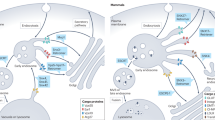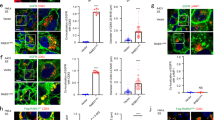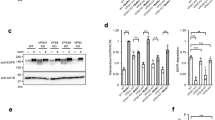Abstract
The endosomal sorting complex required for transport (ESCRT) system is essential for multivesicular body biogenesis, in which cargo sorting is coupled to the invagination and scission of intralumenal vesicles. The ESCRTs are also needed for budding of enveloped viruses including human immunodeficiency virus 1, and for membrane abscission in cytokinesis. In Saccharomyces cerevisiae, ESCRT-III consists of Vps20, Snf7, Vps24 and Vps2 (also known as Did4), which assemble in that order and require the ATPase Vps4 for their disassembly. In this study, the ESCRT-III-dependent budding and scission of intralumenal vesicles into giant unilamellar vesicles was reconstituted and visualized by fluorescence microscopy. Here we show that three subunits of ESCRT-III, Vps20, Snf7 and Vps24, are sufficient to detach intralumenal vesicles. Vps2, the ESCRT-III subunit responsible for recruiting Vps4, and the ATPase activity of Vps4 were required for ESCRT-III recycling and supported additional rounds of budding. The minimum set of ESCRT-III and Vps4 proteins capable of multiple cycles of vesicle detachment corresponds to the ancient set of ESCRT proteins conserved from archaea to animals.
This is a preview of subscription content, access via your institution
Access options
Subscribe to this journal
Receive 51 print issues and online access
$199.00 per year
only $3.90 per issue
Buy this article
- Purchase on SpringerLink
- Instant access to full article PDF
Prices may be subject to local taxes which are calculated during checkout






Similar content being viewed by others
References
Gruenberg, J. & Stenmark, H. The biogenesis of multivesicular endosomes. Nature Rev. Mol. Cell Biol. 5, 317–323 (2004)
Russell, M. R. G., Nickerson, D. P. & Odorizzi, G. Molecular mechanisms of late endosome morphology, identity and sorting. Curr. Opin. Cell Biol. 18, 422–428 (2006)
Slagsvold, T., Pattni, K., Malerod, L. & Stenmark, H. Endosomal and non-endosomal functions of ESCRT proteins. Trends Cell Biol. 16, 317–326 (2006)
Saksena, S., Sun, J., Chu, T. & Emr, S. D. ESCRTing proteins in the endocytic pathway. Trends Biochem. Sci. 32, 561–573 (2007)
Piper, R. C. & Katzmann, D. J. Biogenesis and function of multivesicular bodies. Annu. Rev. Cell Dev. Biol. 23, 519–547 (2007)
Williams, R. L. & Urbe, S. The emerging shape of the ESCRT machinery. Nature Rev. Mol. Cell Biol. 8, 355–368 (2007)
Hurley, J. H. ESCRT Complexes and the biogenesis of multivesicular bodies. Curr. Opin. Cell Biol. 20, 4–11 (2008)
Morita, E. & Sundquist, W. I. Retrovirus budding. Annu. Rev. Cell Dev. Biol. 20, 395–425 (2004)
Bieniasz, P. D. Late budding domains and host proteins in enveloped virus release. Virology 344, 55–63 (2006)
Fujii, K., Hurley, J. H. & Freed, E. O. Beyond Tsg101: the role of Alix in ‘ESCRTing’ HIV-1. Nature Rev. Microbiol. 5, 912–916 (2007)
Carlton, J. G. & Martin-Serrano, J. Parallels between cytokinesis and retroviral budding: a role for the ESCRT machinery. Science 316, 1908–1912 (2007)
Morita, E. et al. Human ESCRT and ALIX proteins interact with proteins of the midbody and function in cytokinesis. EMBO J. 26, 4215–4227 (2007)
Samson, R. Y., Obita, T., Freund, S. M., Williams, R. L. & Bell, S. D. A role for the ESCRT system in cell division in Archaea. Science 322, 1710–1713 (2008)
Lindas, A. C., Karlsson, E. A., Lindgren, M. T., Ettema, T. J. G. & Bernander, R. A unique cell division machinery in the Archaea. Proc. Natl Acad. Sci. USA 105, 18942–18946 (2008)
Hinshaw, J. E. Dynamin and its role in membrane fission. Annu. Rev. Cell Dev. Biol. 16, 483–519 (2000)
Babst, M., Katzmann, D. J., Estepa-Sabal, E. J., Meerloo, T. & Emr, S. D. ESCRT-III: An endosome-associated heterooligomeric protein complex required for MVB sorting. Dev. Cell 3, 271–282 (2002)
Muziol, T. et al. Structural basis for budding by the ESCRT-III factor CHMP3. Dev. Cell 10, 821–830 (2006)
Zamborlini, A. et al. Release of autoinhibition converts ESCRT-III components into potent inhibitors of HIV-1 budding. Proc. Natl Acad. Sci. USA 103, 19140–19145 (2006)
Shim, S., Kimpler, L. A. & Hanson, P. I. Structure/function analysis of four core ESCRT-III proteins reveals common regulatory role for extreme C-terminal domain. Traffic 8, 1068–1079 (2007)
Hanson, P. I., Roth, R., Lin, Y. & Heuser, J. E. Plasma membrane deformation by circular arrays of ESCRT-III protein filaments. J. Cell Biol. 180, 389–402 (2008)
Babst, M., Wendland, B., Estepa, E. J. & Emr, S. D. The Vps4p AAA ATPase regulates membrane association of a Vps protein complex required for normal endosome function. EMBO J. 17, 2982–2993 (1998)
Obita, T. et al. Structural basis for selective recognition of ESCRT-III by the AAA ATPase Vps4. Nature 449, 735–739 (2007)
Stuchell-Brereton, M. et al. ESCRT-III recognition by VPS4 ATPases. Nature 449, 740–744 (2007)
Kieffer, C. et al. Two distinct modes of ESCRT-III recognition are required for VPS4 functions in lysosomal protein targeting and HIV-1 budding. Dev. Cell 15, 62–73 (2008)
Ghazi-Tabatabai, S. et al. Structure and disassembly of filaments formed by the ESCRT-III subunit Vps24. Structure 16, 1345–1356 (2008)
Lata, S. et al. Helical structures of ESCRT-III are disassembled by VPS4. Science 321, 1354–1357 (2008)
Matsuo, H. et al. Role of LBPA and Alix in multivesicular liposome formation and endosome organization. Science 303, 531–534 (2004)
Trajkovic, K. et al. Ceramide triggers budding of exosome vesicles into multivesicular endosomes. Science 319, 1244–1247 (2008)
Sens, P., Johannes, L. & Bassereau, P. Biophysical approaches to protein-induced membrane deformations in trafficking. Curr. Opin. Cell Biol. 20, 476–482 (2008)
Romer, W. et al. Shiga toxin induces tubular membrane invaginations for its uptake into cells. Nature 450, 670–675 (2007)
Teo, H., Perisic, O., Gonzalez, B. & Williams, R. L. ESCRT-II, an endosome-associated complex required for protein sorting: crystal structure and interactions with ESCRT-III and membranes. Dev. Cell 7, 559–569 (2004)
Evans, W. H. & Hardison, W. G. Phospholipid, cholesterol, polypeptide and glycoprotein composition of hepatic endosome subfractions. Biochem. J. 232, 33–36 (1985)
Kobayashi, T. et al. Separation and characterization of late endosomal membrane domains. J. Biol. Chem. 277, 32157–32164 (2002)
Angelova, M. I. & Dimitrov, D. S. Liposome electroformation. Faraday Discuss. Chem. Soc. 81, 303–311 (1986)
Teis, D., Saksena, S. & Emr, S. D. Ordered assembly of the ESCRT-III complex on endosomes is required to sequester cargo during MVB formation. Dev. Cell 15, 578–589 (2008)
Nickerson, D. P., West, M. & Odorizzi, G. Did2 coordinates Vps4-mediated dissociation of ESCRT-III from endosomes. J. Cell Biol. 175, 715–720 (2006)
Kostelansky, M. S. et al. Molecular architecture and functional model of the complete yeast ESCRT-I heterotetramer. Cell 129, 485–498 (2007)
Wickner, W. & Schekman, R. Membrane fusion. Nature Struct. Mol. Biol. 15, 658–664 (2008)
Acknowledgements
We thank V. Schram and the NICHD imaging core facility for use of the LSM5 LiveDuo microscope, D. Yang and G. Patterson for providing purified Vps4 and GFP, respectively, B. Beach for assistance with subcloning, E. Tyler for generating Fig. 6 and Supplementary Movie 3, Y. Im for assistance with Supplementary Fig. 1, C. Biertümpfel and W. Yang for use of their light-scattering instrument, and members of the Hurley and Lippincott-Schwartz laboratories for discussions. This research was supported by the Intramural Program of the National Institutes of Health, NICHD (J.L.-S.), NIDDK (J.H.H.) and IATAP (J.H.H. and J.L.-S.). T.W. is an EMBO long-term fellow.
Author Contributions T.W. and C.W. prepared GUVs and carried out confocal microscopy; T.W. purified and labelled proteins; C.W. carried out the three-dimensional reconstruction; T.W., C.W., J.L.-S. and J.H.H. analysed data; J.H.H. designed the study and wrote the manuscript.
Author information
Authors and Affiliations
Corresponding author
Supplementary information
Supplementary Information
This file contains Supplementary Figures S1-S3 with Legends and Supplementary Movies Legends S1-S3 (PDF 1670 kb)
Supplementary Movie S1
This file shows 3D reconstruction of a GUV (see file s1 for full legend). (MOV 14472 kb)
Supplementary Movie S2
The file shows ILV dynamics (see file s1 for full legend). (MOV 1444 kb)
Supplementary Movie S3
The file shows animation of model for ILV scission (see file s1 for full legend). (MOV 8429 kb)
Rights and permissions
About this article
Cite this article
Wollert, T., Wunder, C., Lippincott-Schwartz, J. et al. Membrane scission by the ESCRT-III complex. Nature 458, 172–177 (2009). https://doi.org/10.1038/nature07836
Received:
Accepted:
Published:
Issue Date:
DOI: https://doi.org/10.1038/nature07836
This article is cited by
-
Recent advances in the roles of exosomal microRNAs (exomiRs) in hematologic neoplasms: pathogenesis, diagnosis, and treatment
Cell Communication and Signaling (2023)
-
Exosome, the glass slipper for Cinderella of cancer—bladder cancer?
Journal of Nanobiotechnology (2023)
-
An oocyte meiotic midbody cap is required for developmental competence in mice
Nature Communications (2023)
-
HSF-1 enhances cardioprotective potential of stem cells via exosome biogenesis and their miRNA cargo enrichment
Stem Cell Reviews and Reports (2023)
-
Snf7 spirals sense and alter membrane curvature
Nature Communications (2022)



